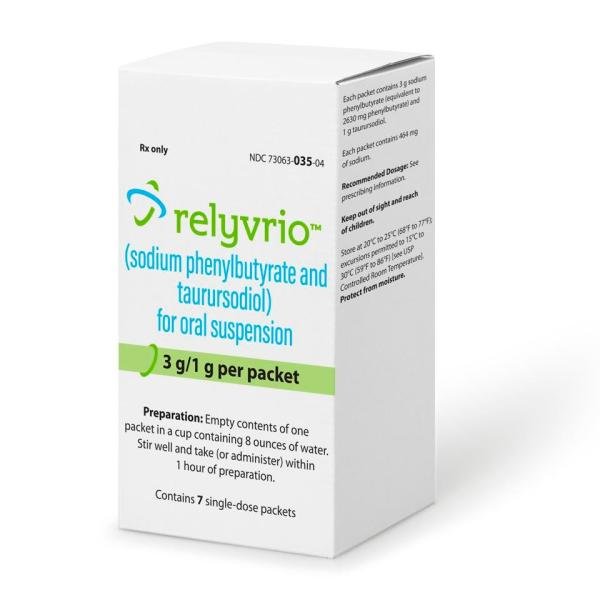Relyvrio Disease Interactions
There are 4 disease interactions with Relyvrio (sodium phenylbutyrate / taurursodiol).
Sodium phenylbutyrate (applies to Relyvrio) fluid retention
Major Potential Hazard, High plausibility. Applicable conditions: Congestive Heart Failure, Renal Dysfunction
The use of sodium phenylbutyrate may cause fluid retention in patients with congestive heart failure, renal dysfunction, or sodium retention with edema. Sodium phenylbutyrate is primarily excreted by the kidney and these patients may exhibit reduced excretion. Therapy with sodium phenylbutyrate should be administered cautiously in these patients. Monitoring plasma levels of ammonia, arginine, branched-chain amino acids and serum proteins to maintain within normal limits and glutamine to less than 1000 mcmol/L is recommended.
Sodium phenylbutyrate (applies to Relyvrio) liver/kidney disease
Moderate Potential Hazard, High plausibility. Applicable conditions: Liver Disease, Renal Dysfunction
Sodium phenylbutyrate is primarily metabolized in the liver and kidney. Therapy with sodium phenylbutyrate should be administered cautiously in patients with liver disease. Monitoring plasma levels of ammonia, arginine, branched-chain amino acids and serum proteins to maintain within normal limits and glutamine to less than 1000 mcmol/L is recommended.
Sodium phenylbutyrate (applies to Relyvrio) neurotoxicity
Moderate Potential Hazard, Moderate plausibility. Applicable conditions: CNS Disorder, Myoneural Disorder, Peripheral Neuropathy
Sodium phenylbutyrate is a pro-drug and is rapidly metabolized to the active, phenylacetate. Neurotoxicity, including exacerbation of a preexisting neuropathy, has been reported with the use of intravenous phenylacetate. The acute onset and reversibility when the phenylacetate infusion was discontinued suggested a drug effect. Care should be exercised when prescribing sodium phenylbutyrate to patients at risk for neurotoxicity.
Taurursodiol (applies to Relyvrio) biliary disorders
Moderate Potential Hazard, Moderate plausibility. Applicable conditions: Biliary Obstruction, Gallbladder Disease, Malabsorption Syndrome
Sodium phenylbutyrate-taurursodiol contains taurursodiol, a bile acid. In patients with disorders that interfere with bile acid circulation, there may be an increased risk for diarrhea and patients should be monitored appropriately. Other conditions such as pancreatic insufficiency, intestinal malabsorption, or intestinal diseases that may alter the concentration of bile acids, may also lead to decreased absorption of this drug and its components. Consider consulting with a GI specialists with experience managing these GI disorders. Patients with disorders of enterohepatic circulation (e.g., biliary infection, active cholecystitis, etc.), severe pancreatic disorders (e.g., pancreatitis), and intestinal disorders that may alter concentrations of bile acids (e.g., ileal resection, regional ileitis, etc.) were excluded from clinical studies and there is no experience in patients with these conditions. Caution is advised.
Switch to professional interaction data
Relyvrio drug interactions
There are 585 drug interactions with Relyvrio (sodium phenylbutyrate / taurursodiol).
Relyvrio alcohol/food interactions
There are 3 alcohol/food interactions with Relyvrio (sodium phenylbutyrate / taurursodiol).
More about Relyvrio (sodium phenylbutyrate / taurursodiol)
- Relyvrio consumer information
- Check interactions
- Compare alternatives
- Drug images
- Side effects
- Dosage information
- During pregnancy
- FDA approval history
- Drug class: miscellaneous central nervous system agents
- En español
Related treatment guides
Drug Interaction Classification
| Highly clinically significant. Avoid combinations; the risk of the interaction outweighs the benefit. | |
| Moderately clinically significant. Usually avoid combinations; use it only under special circumstances. | |
| Minimally clinically significant. Minimize risk; assess risk and consider an alternative drug, take steps to circumvent the interaction risk and/or institute a monitoring plan. | |
| No interaction information available. |
See also:
Further information
Always consult your healthcare provider to ensure the information displayed on this page applies to your personal circumstances.


